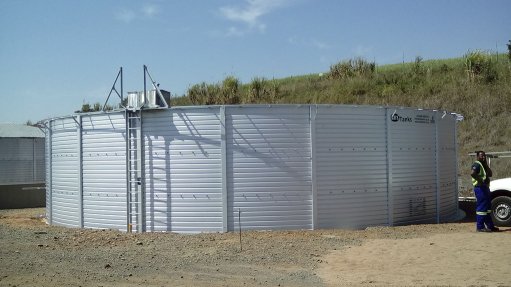
SAFELY CONTAINED Once the leachate liquid is safely contained, it requires further processing to obtain an environmentally safe liquid
Industrial and commercial steel water-tank manufacturer SBS has recently installed a 500 m³ capacity landfill leachate storage tank with a floating cover at a landfill site in Stanger, KwaZulu-Natal.
The ST21-03 SBS tank measures 14.33 m in diameter and 3.17 m in height.
The primary use of leachate tanks is to safely store landfill leachate, which is predominantly produced from rainwater runoff, says SBS Group chief financial and operations officer Heiner Freese.
“When it rains at a landfill site, water filters through the decomposing solid waste. As it filters through the solid waste, it collects impurities and becomes contaminated.”
This contaminated liquid is hazardous to the environment and, therefore, needs to be contained to ensure that it does not enter the groundwater or other aquatic environments. Once the leachate liquid is safely contained, it requires further processing to produce an environmentally safe liquid, he explains.
Leachate liquid has a strong odour, notes Freese, adding that the floating cover supresses and contains this odour to ensure that it does not reach and affect nearby communities.
The tanks consist of the tank shell, liner and a floating roof cover.
The tank shell, in turn, consists of Zincalume-coated, high-yield-strength steel bolt panels. The prefabricated Zincalume coating helps to fast-track conveyance and installation, and is lighter and easier to work with, compared with other material.
Additionally, the tanks have an internal liner made from a flexible high-strength and chemically resistant geomembrane material. The geomembrane liner prevents seepage, therefore preventing groundwater contamination and subsequent environmental hazards.
He adds that the liner also ensures there is a barrier between the corrosive leachate liquid and the tank structure.
The floating roof cover floats on the surface of the water and prevents rainwater, insects and birds from entering the tank while preventing the liquid from evaporating. The roof also reduces algae growth.
The cover includes a weighted flotation unit system, which is required for wind stabilisation of the cover.
The modular design of these tanks allows for easy of transportation to site, especially in remote locations.
“The company does not need to construct infrastructure like roads to access the build location, as would be the case with typical concrete reservoirs. Additionally, SBS’s reservoirs are installed using a jacking system from ground level, which means there is no need for scaffolding or cranes on site,” Freese concludes.